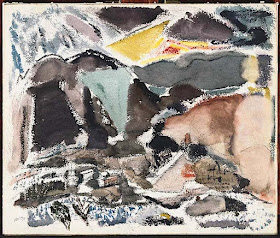JOHN MARIN (1870-1953)
Bear Mountain (393m - 1,289ft)
United States of America
Bear Mountain (393m - 1,289ft) is one of the best-known peaks of New York's Hudson Highlands. Located partially in Orange County in the town of Highlands and partially in Rockland County in the town of Stony Point, it lends its name to the nearby Bear Mountain Bridge and Bear Mountain State Park that contains it. Its summit, accessible by a paved road, has several roadside viewpoints, a picnic area and an observatory, the Perkins Memorial Tower. It is crossed by several hiking trails as well, including the oldest section of the Appalachian Trail (AT). As of 2015, the AT across Bear Mountain is continuing to be improved by the New York–New Jersey Trail Conference to minimize erosion and improve accessibility and sustainability as part of a project to rebuild and realign the trail that began in 2006.
The steep eastern face of the mountain overlooks the Hudson River. The eastern side of the mountain consists of a pile of massive boulders, often the size of houses, that culminate in a 50-foot (15 m) cliff face at approximately the 1,000-foot (300 m) level. A direct scramble from the shore of Hessian Lake to Perkins Memorial Drive on the summit requires a gain of about 1,000 feet (300 m) in roughly 0.8 miles (1.3 km). From the summit, one can see as far as Manhattan, and the monument on High Point in New Jersey.
The painter
John Marin was a seminal American modernist painter. He was one of the first Americans to employ techniques of abstraction in his calligraphic depictions of landscapes and city streets. Along with Arthur Dove, Marsden Hartley, and Georgia O’Keeffe, Marin helped introduce a new aesthetic model for American painters. “I must for myself insist that when finished, that is when all the parts are in place and are working, that now it has become an object and will therefore have its boundaries as definite as the prow, the stern, the sides, and bottom bound as a boat” he once reflected.
Marin started his career in art later in life, graduating from the Pennsylvania Academy of the Fine Arts in 1901 at the age of 30. In 1905, he travelled to Europe, lived in Paris (1905-1909) where he developed his signature watercolor technique and met the artist Edward Steichen. It was Steichen that introduced his work to the photographer Alfred Stieglitz, who mounted Marin’s first solo show in 1909, and financially supported the artist over the remainder of his career.
Today, his works are held in the collections of The Museum of Modern Art in New York, the Phillips Collection in Washington, D.C., and the Art Institute of Chicago, among others.
He developed a more dynamic, fractured style from 1912 to depict the interaction of conflicting forces, and gradually evolved summary ways of rendering his vivid impressions of sea, sky, mountains or the skyscrapers of Manhattan. In the 1920s worked almost exclusively in watercolour; after 1930 painted largely in oils.
2018 - Wandering Vertexes...
by Francis Rousseau
